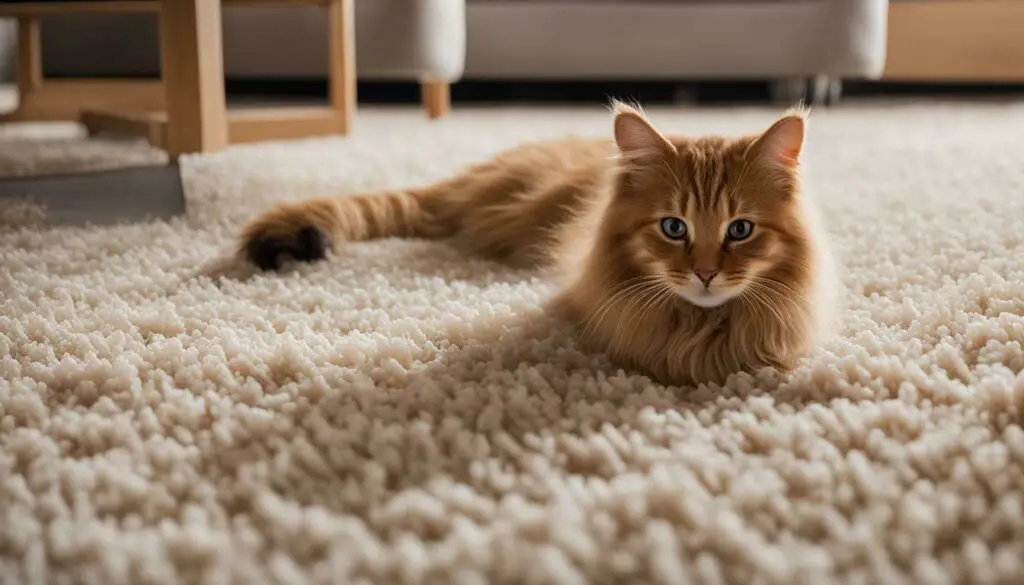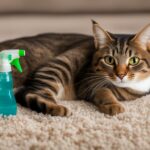Dealing with the lingering smell of cat urine in your carpet can be frustrating, but with the right methods and tips, you can eliminate the odor for good.
Key Takeaways:
- Professional carpet cleaning using a hot water extraction process is highly effective in removing cat urine smell.
- Different DIY methods like vinegar and water solution, hydrogen peroxide, and baking soda can also help eliminate the odor.
- Soak up and remove as much urine as possible before applying cleaning products.
- Retraining your cat and maintaining a clean litter box are essential in preventing future accidents.
- Enzyme cleaners are recommended for removing cat urine odor and should be applied as per the instructions on the label.
The Importance of Professional Carpet Cleaning
When it comes to getting rid of cat urine smell from your carpet, professional carpet cleaning is often the most effective solution. Cats have a strong sense of smell and can be attracted back to areas where they have previously urinated. That’s why it’s crucial to thoroughly clean and eliminate the odor to prevent repeat accidents.
Professional carpet cleaning companies have the expertise and specialized equipment to tackle tough stains and odors caused by cat urine. They use a hot water extraction process that penetrates deep into the carpet fibers, effectively removing urine residue and odor-causing bacteria.
When hiring a professional carpet cleaning service, make sure to ask if they specialize in pet and urine cleaning. These professionals have the necessary knowledge and products to effectively neutralize the odor and remove the stains. They understand the importance of using pet-safe and environmentally friendly cleaning agents, ensuring the health and safety of your beloved pets.
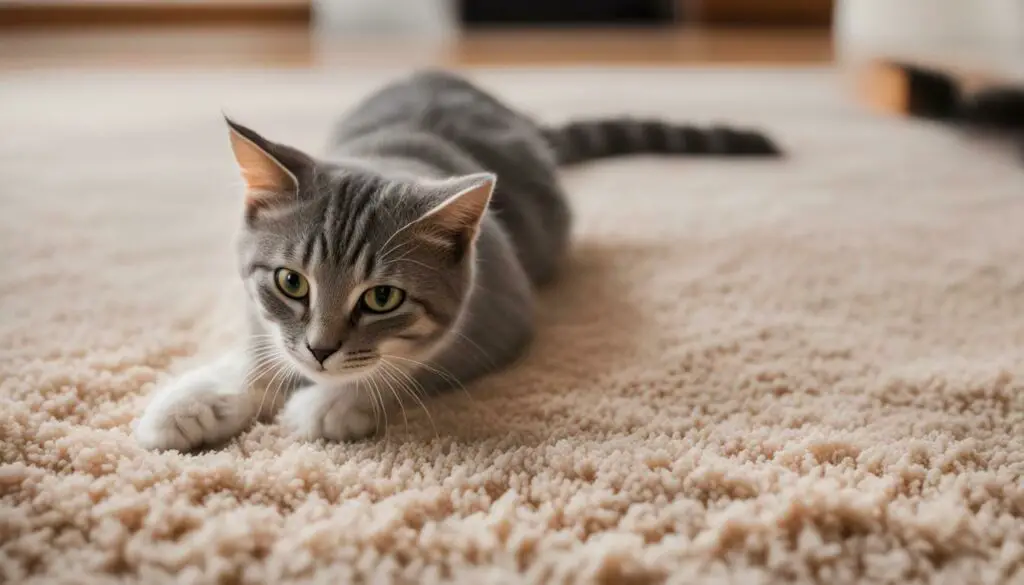
Additional Tips for Effective Carpet Cleaning
- Soak up and remove as much urine as possible before applying any cleaning products. Use paper towels or a clean cloth to blot the area gently.
- If you prefer to tackle the task yourself, there are DIY methods that can help remove cat urine smell from your carpet. Try using a vinegar and water solution, hydrogen peroxide, or baking soda. Always test these products in an inconspicuous area of the carpet before applying them to the stained area.
- Retrain your cats and ensure their litter boxes are clean and accessible. Cats may urinate outside the litter box due to stress, health issues, or a dirty litter box. Regular cleaning and maintenance of the litter box are essential in preventing future accidents.
- Consider using dog-training urine pads under the litter box as an added layer of protection. These pads can absorb any urine that may leak from the litter box, preventing it from seeping into the carpet.
- Enzyme cleaners are highly recommended for removing the odor and stains caused by cat urine. Follow the instructions on the label and saturate the affected area thoroughly. These cleaners break down the urine molecules, effectively eliminating the odor at its source.
- Rinse the treated area with clean water and blot with a towel to remove any excess moisture. This step helps neutralize the cat urine odor and prevents any residue from attracting your cat back to the spot.
- If the smell persists or you suspect hidden urine deposits, use a UV light to identify the affected areas. Urine deposits may be present in places that are not visible to the naked eye, contributing to lingering odors.
- In extreme cases where the cat urine smell is deeply ingrained in the carpet pad and subfloor, it may be necessary to replace these components. This ensures complete removal of the odor and prevents future reoccurrence.
| Professional Carpet Cleaning Pros | DIY Methods Pros |
|---|---|
| Highly effective in removing cat urine smell | Cost-effective solution |
| Specialized equipment and expertise | Accessible and convenient |
| Safe for pets and the environment | Can be used as a temporary solution |
Professional carpet cleaning is the best option for effectively removing cat urine smell from your carpet. Their expertise and specialized equipment ensure a thorough clean and odor elimination.”
– Expert carpet cleaner
DIY Methods for Removing Cat Urine Smell
If you prefer a do-it-yourself approach, there are several methods you can try to remove cat urine smell from your carpet. These DIY methods are cost-effective and can be done with ingredients you likely already have at home. Here are three effective options:
Vinegar and Water Solution
Mixing vinegar and water creates a natural cleaning solution that can help eliminate cat urine odor. Start by blotting up any excess urine using paper towels or a clean cloth. Then, mix equal parts white vinegar and water in a spray bottle. Liberally spray the solution onto the affected area and let it sit for 5-10 minutes. Blot the area with a clean cloth to absorb the moisture. Finally, rinse the area with clean water and blot again until dry. The acidic nature of vinegar helps neutralize the odor, leaving your carpet smelling fresh.
Hydrogen Peroxide
Hydrogen peroxide is another effective ingredient for removing cat urine smell from carpet. Start by blotting up the urine and then mix equal parts hydrogen peroxide and water in a spray bottle. Test the solution on an inconspicuous area of your carpet first to ensure it doesn’t cause any discoloration. If it’s safe, spray the solution onto the affected area and let it sit for 15-20 minutes. Blot the area with a clean cloth to remove any excess liquid. Finally, rinse the area with clean water and blot until dry. Hydrogen peroxide helps break down the odor-causing compounds in cat urine, effectively removing the smell.
Baking Soda
Baking soda is a versatile ingredient known for its odor-absorbing properties. After blotting up the urine, sprinkle a generous amount of baking soda over the affected area. Gently work the baking soda into the carpet fibers using a soft brush or your fingers. Let it sit overnight to give it time to absorb the odor. The next day, vacuum the area to remove the baking soda and any remaining odor. Baking soda is a safe and effective way to eliminate cat urine smell while leaving your carpet clean and fresh.
Remember, regardless of which DIY method you choose, it’s essential to thoroughly soak up as much urine as possible before applying any products. This will help the cleaning solution penetrate deeply into the carpet fibers and ensure a more effective result. Additionally, always test the products on a small, inconspicuous area of your carpet before treating the entire stain to avoid any potential damage or discoloration.
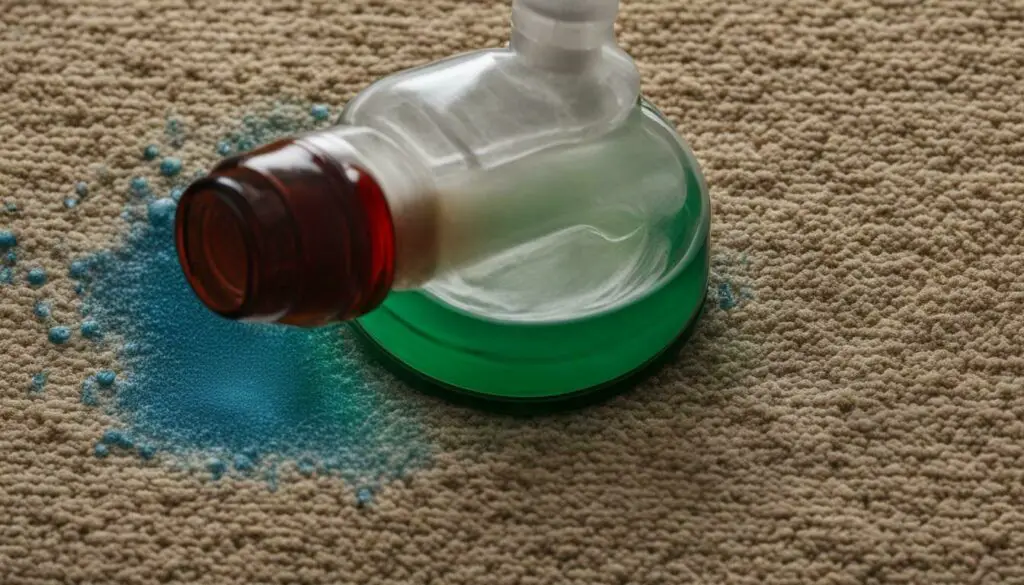
| DIY Methods for Removing Cat Urine Smell | Pros | Cons |
|---|---|---|
| Vinegar and Water Solution | Cost-effective, natural, and easily accessible ingredients | May have a strong vinegar odor initially, requires rinsing and blotting |
| Hydrogen Peroxide | Effective in breaking down odor-causing compounds | May cause discoloration on certain types of carpets, requires rinsing and blotting |
| Baking Soda | Safe and non-toxic, absorbs odors effectively | Requires overnight treatment and thorough vacuuming |
Removing Fresh Urine and Soaking Up Odor
Acting fast is crucial when it comes to dealing with fresh cat urine on your carpet and preventing lingering odors. The longer the urine sits, the harder it becomes to remove both the stain and the smell. To effectively tackle this issue, follow these steps:
- Start by using paper towels or a clean cloth to blot up as much urine as possible. Gently press down on the spot, absorbing the liquid without rubbing or scrubbing, as this can spread the urine and push it deeper into the carpet fibers.
- Once you have soaked up as much urine as you can, it’s time to treat the area. A vinegar and water solution can be highly effective in neutralizing the odor. Mix equal parts white vinegar and water, and then use a spray bottle to apply the solution to the affected area. Allow it to sit for a few minutes.
- Next, create a paste using hydrogen peroxide and baking soda. Apply this paste to the area, ensuring that it covers the entire stained region. The baking soda acts as a natural deodorizer, while the hydrogen peroxide helps to eliminate stubborn stains and odors.
Leave the paste on the carpet for about 15-20 minutes. During this time, the paste will work its magic, breaking down the urine and neutralizing the odor. Afterward, use a paper towel or cloth to blot up any excess moisture.
| Ingredients | Measurements |
|---|---|
| White vinegar | Equal parts |
| Water | Equal parts |
| Baking soda | To create a paste |
| Hydrogen peroxide | To create a paste |
Remember, when using any cleaning solution, it is essential to test it on a small, inconspicuous area of the carpet before applying it to the stained spot. This ensures that the solution doesn’t cause any discoloration or damage to your carpet fibers. Additionally, be sure to follow the instructions provided by the manufacturer of the cleaning products you are using.

The next section will delve into retraining your cat and proper litter box maintenance, which are important steps in preventing future accidents and keeping your carpet fresh and odor-free.
Retraining Your Cat and Proper Litter Box Maintenance
To address the underlying issue of cat urine smell in your carpet, it’s important to retrain your cat and ensure proper litter box maintenance.
Retraining your cat requires patience and consistency. Start by identifying any possible reasons why your cat may be avoiding the litter box, such as a dirty or inconveniently placed litter box, improper litter substrate, or underlying medical issues. Once you address these issues, you can begin retraining.
Here are some steps to help you retrain your cat:
- Keep the litter box clean: Cats are naturally clean animals and may refuse to use a dirty litter box. Scoop the litter daily and fully replace it at least once a week.
- Provide multiple litter boxes: It’s recommended to have one litter box per cat, plus an extra one. This ensures that each cat has access to their own box and reduces competition or territorial issues.
- Choose the right litter substrate: Cats have preferences when it comes to litter substrates. Experiment with different types, such as clay, clumping, or natural alternatives, to see which one your cat prefers.
- Place litter boxes strategically: Cats prefer privacy when using the litter box. Keep the boxes in quiet, low-traffic areas of your home, away from their food and water bowls.
- Reward positive behavior: When your cat uses the litter box correctly, praise them and offer a small treat as positive reinforcement.
In addition to retraining your cat, regular litter box maintenance is crucial in preventing future accidents. Here are some tips:
- Scoop the litter box daily to remove waste and clumps.
- Thoroughly clean and disinfect the litter box at least once a month. Use a mild detergent and rinse it thoroughly before refilling with clean litter.
- Replace the litter box entirely every 12 to 18 months to prevent the buildup of odor-causing bacteria.
Following these retraining and maintenance methods can help eliminate the recurring issue of cat urine smell in your carpet. Remember, consistency and patience are key when retraining your cat. With proper litter box habits and a clean environment, you can ensure a fresh-smelling home for both you and your furry friend.
Using Dog-Training Urine Pads for Added Protection
An effective way to minimize the chances of cat urine reaching your carpet is by using dog-training urine pads underneath the litter box. These pads are specially designed to absorb and contain liquids, preventing them from seeping through and causing stains or odors on your carpet. By placing a urine pad under the litter box, you create an extra layer of protection that helps safeguard your carpet from potential accidents.
Not only do dog-training urine pads provide added protection, but they also make cleanup easier. If your cat has an accident outside of the litter box, the pad will soak up the urine, making it simpler to clean up the mess. Additionally, these pads are disposable, so you can easily remove and replace them as needed.
When using dog-training urine pads, it’s essential to choose ones that are the appropriate size for your litter box. You want the pad to be large enough to cover the area directly beneath the box to catch any urine that might escape. Place the pad with the absorbent side facing up, ensuring maximum absorption.
Remember, while dog-training urine pads can provide added protection, they are not a substitute for proper litter box maintenance and cat training. Regularly cleaning the litter box and providing your cat with a comfortable and stress-free environment will help prevent accidents and minimize the chances of urine reaching your carpet.
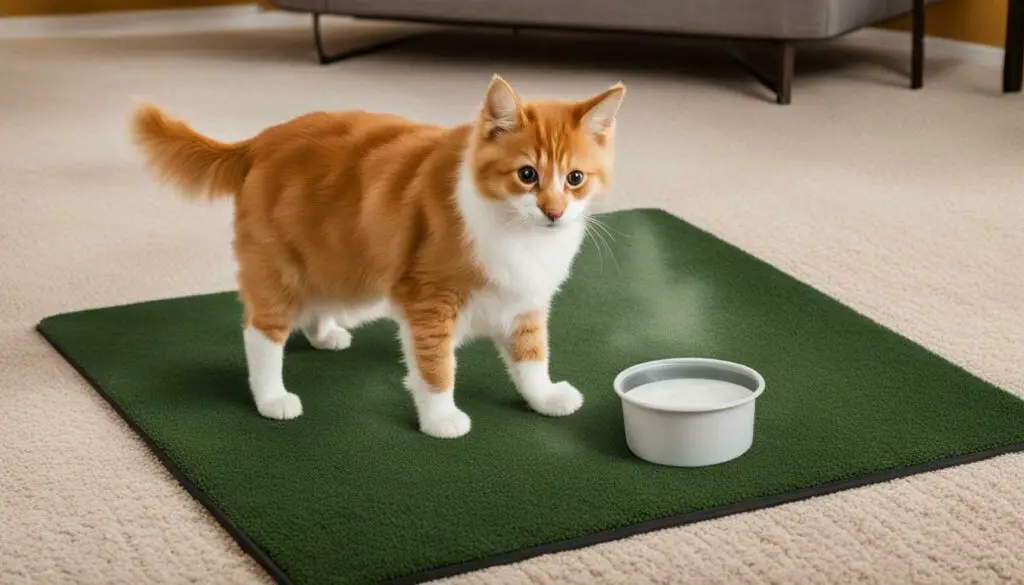
| Benefits of Using Dog-Training Urine Pads |
|---|
| Provides an extra layer of protection for your carpet |
| Absorbs and contains liquid, preventing stains and odors |
| Makes cleanup easier in case of accidents |
| Disposable and easy to replace |
The Power of Enzyme Cleaners
When it comes to tackling cat urine odor, enzyme cleaners can be powerful tools in neutralizing the smell and removing stains. These cleaners contain specialized enzymes that break down the urine molecules at a molecular level, effectively eliminating the source of the odor. Not only do enzyme cleaners eliminate the smell, but they also help prevent re-marking by removing the scent markers left behind by your cat.

Enzyme cleaners are safe to use on a variety of surfaces, including carpets, upholstery, and even hardwood floors. However, it’s important to read and follow the instructions on the label to ensure proper usage. To effectively use an enzyme cleaner, begin by thoroughly saturating the affected area. This allows the enzymes to penetrate deep into the carpet fibers or other surfaces where the urine has soaked.
After applying the cleaner, be patient and allow it to sit for the recommended amount of time. This gives the enzymes enough time to break down the urine molecules and neutralize the odor. Once the waiting time is up, rinse the area with clean water to remove any residue. Finally, blot the area with a clean towel to remove excess moisture. It’s important to note that using a regular household cleaner before applying the enzyme cleaner can significantly reduce its effectiveness, as the chemicals in these cleaners can deactivate the enzymes.
If you’re dealing with persistent smells or are unsure if you’ve fully eliminated all urine deposits, using a UV light can be helpful. UV lights can detect hidden urine stains that may not be visible to the naked eye. Simply turn off the lights in the room and scan the area with the UV light. The urine stains will glow under the light, allowing you to pinpoint their exact location for further treatment.
| Benefits of Enzyme Cleaners |
|---|
| Neutralizes cat urine odor at a molecular level |
| Removes stains and prevents re-marking |
| Safe to use on various surfaces |
| Helps detect hidden urine stains with UV light |
By harnessing the power of enzyme cleaners, you can effectively eliminate cat urine odor and keep your home smelling fresh and clean. Remember to always choose a high-quality enzyme cleaner and follow the instructions carefully for best results. With the right approach, you can say goodbye to cat urine smells and enjoy a odor-free environment.
Thoroughly Saturating the Affected Area
To ensure effective cat urine stain and odor removal from your carpet, it’s crucial to thoroughly saturate the affected area with your chosen cleaning solution. Whether using a commercial enzyme cleaner or a DIY solution like vinegar and water, the key is to apply enough product to penetrate deep into the carpet fibers and reach the source of the odor.
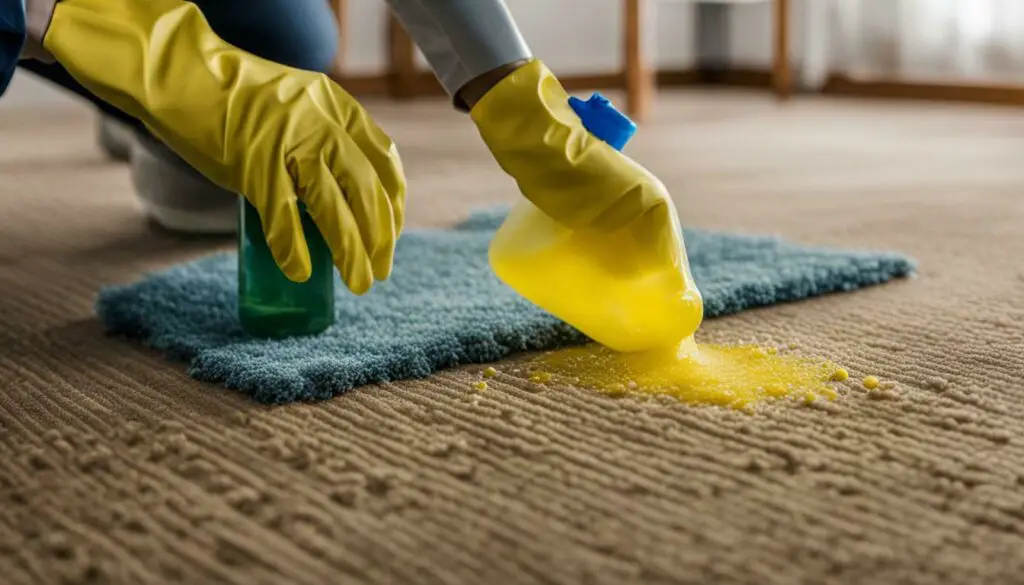
Start by carefully blotting up any excess urine with a clean towel or paper towels. Avoid rubbing or scrubbing, as this can spread the stain and odor further into the carpet. Once the area is mostly dry, you can proceed with applying the cleaning solution.
If using a commercial enzyme cleaner, follow the instructions on the label for the recommended amount to apply. Make sure to cover the entire stained area and extend the application slightly beyond the visible stain to ensure complete saturation. Use a clean cloth or sponge to work the cleaner into the carpet, gently agitating the fibers to help break down the urine molecules.
| Tip: | For DIY solutions, such as vinegar and water or hydrogen peroxide and baking soda, mix the ingredients according to online guidelines. Test the solution on a small, inconspicuous area of the carpet first to check for any adverse reactions. Once confirmed safe, apply the solution directly to the stained area and use a cloth or sponge to work it in. |
|---|
After saturating the affected area, allow the cleaning solution to sit for the recommended amount of time specified on the product label or in the DIY instructions. This allows the enzymes or cleaning agents to break down the urine and eliminate the odor-causing bacteria.
Remember, thorough saturation is key to effectively remove cat urine stains and odors from your carpet. Taking the time to apply the cleaning solution properly will increase the chances of success in restoring your carpet to a clean and fresh state.
Rinsing and Blotting the Area
After treating the cat urine smell on your carpet, it’s important to rinse the area thoroughly and blot any excess moisture to neutralize the odor. This step is crucial in completing the cleaning process and ensuring that no residue is left behind.
To begin, fill a spray bottle with clean water and generously spray the treated area. Use a clean cloth or sponge to gently blot the moistened area, soaking up any remaining cleaning solution or urine. Avoid rubbing the carpet vigorously as this can damage the fibers and spread the stain.
Continue to rinse and blot the area multiple times until the water runs clear and there is no longer any odor. Be patient and thorough during this step to effectively remove any traces of cat urine and the cleaning products used.
Once you have completed rinsing and blotting, allow the carpet to air dry completely. Open windows or use fans to promote air circulation and speed up the drying process. Avoid walking on the damp carpet until it is fully dry to prevent any recontamination or damage.
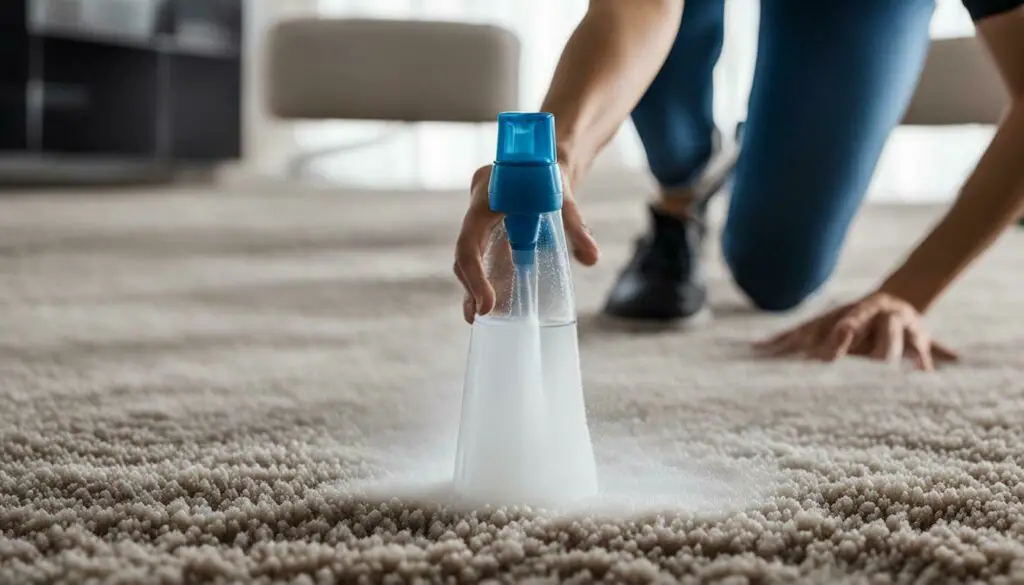
Remember, proper rinsing and blotting are essential in getting rid of cat urine smell from your carpet. By following these steps, you can effectively neutralize the odor and ensure a fresh and clean environment for you and your feline friends.
Using UV Light to Identify Hidden Urine Deposits
If the cat urine smell persists even after cleaning, using a UV light can help you identify hidden urine deposits that may be the source of the odor. UV light, also known as black light, emits ultraviolet radiation that can detect the presence of urine stains, even if they are not visible to the naked eye. This powerful tool is commonly used by professional cleaners to locate urine deposits and ensure thorough elimination of the odor.
Using a UV light is like having x-ray vision for urine stains. It allows you to pinpoint exactly where the problem areas are, enabling you to target your cleaning efforts and eliminate the odor at its source.
To use a UV light, simply turn off all other sources of light in the room and scan the carpet in a systematic manner. The urine stains will appear fluorescent and glow under the UV light, making them easy to identify. Pay close attention to areas where your cat frequently urinates or where you have previously detected the odor. These are likely spots where hidden urine deposits may be lurking.
Once you have identified the urine stains with the UV light, it’s crucial to treat them with an appropriate cleaning solution. Enzyme cleaners are specially formulated to break down the uric acid crystals in the urine, eliminating both the stain and the odor. Follow the instructions on the label and ensure that the affected area is thoroughly saturated with the cleaner. Allow it to sit for the recommended amount of time before blotting up any excess moisture.
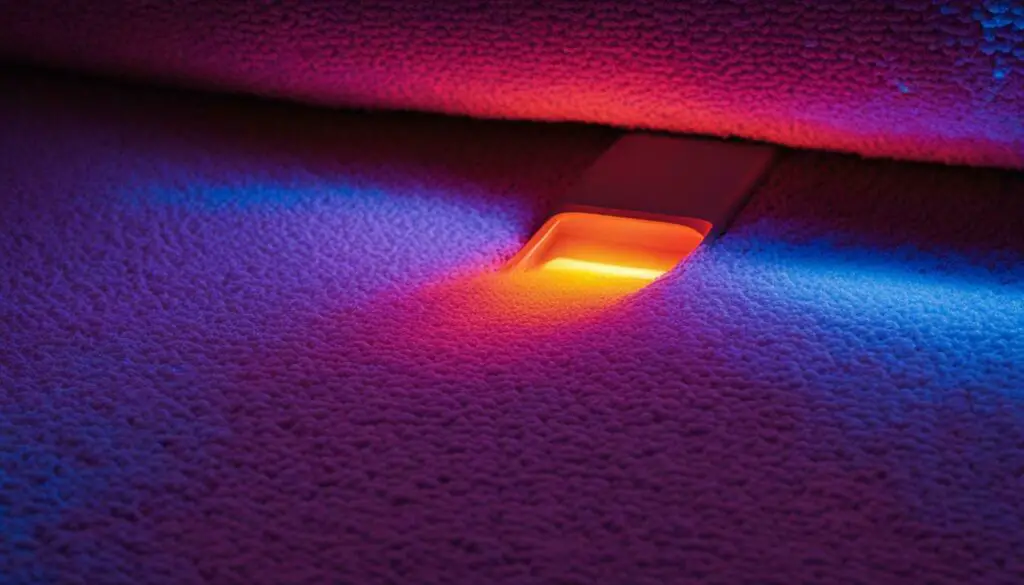
| Benefits of using UV light to identify hidden urine deposits: |
|---|
| 1. Precise detection of urine stains. |
| 2. Targeted cleaning to eliminate odor at the source. |
| 3. Prevents reoccurrence by ensuring thorough cleaning. |
| 4. Provides peace of mind knowing that all hidden urine deposits have been addressed. |
Using a UV light to identify hidden urine deposits can be a game-changer in your battle against cat urine smell. It allows you to effectively target your cleaning efforts and ensure that no trace of urine is left behind. Remember to always follow up with the appropriate cleaning solution to fully eliminate the odor and prevent future accidents.
Dealing with Extreme Cases: Replacing Carpet Pad and Subfloor
In extreme cases, when the cat urine odor is deeply embedded in the carpet pad and subfloor, replacing these components may be necessary to completely eliminate the smell. This is because the urine can penetrate through the carpet fibers and seep into the pad and subfloor beneath, making it difficult to remove the odor without taking more drastic measures.
To replace the carpet pad and subfloor, it is recommended to hire a professional carpet installer or a handyman with experience in this type of work. They will have the necessary tools and expertise to efficiently remove the old pad and subfloor, and install new ones.
Before replacing the carpet pad and subfloor, it is important to thoroughly clean the affected area to minimize the spread of odor-causing bacteria. Use an enzyme cleaner specifically designed for removing cat urine odors and stains. Apply the cleaner to the affected area and let it sit for the recommended amount of time, allowing the enzymes to break down the urine compounds.
After cleaning, remove the old carpet pad and subfloor, ensuring all traces of urine-contaminated materials are discarded. Install new carpet pad and subfloor, following the manufacturer’s instructions or consulting with the professional doing the work. Once the new components are in place, ensure the area is dry and odor-free before installing the new carpet.
Replacing Carpet Pad and Subfloor – Step-by-Step
- Clean the affected area with an enzyme cleaner to minimize odor-causing bacteria.
- Remove the old carpet pad and subfloor, discarding all urine-contaminated materials.
- Install new carpet pad and subfloor, following manufacturer’s instructions or consulting with a professional.
- Ensure the area is dry and odor-free before installing the new carpet.
| Step | Action |
|---|---|
| 1 | Clean the affected area with an enzyme cleaner to minimize odor-causing bacteria. |
| 2 | Remove the old carpet pad and subfloor, discarding all urine-contaminated materials. |
| 3 | Install new carpet pad and subfloor, following manufacturer’s instructions or consulting with a professional. |
| 4 | Ensure the area is dry and odor-free before installing the new carpet. |
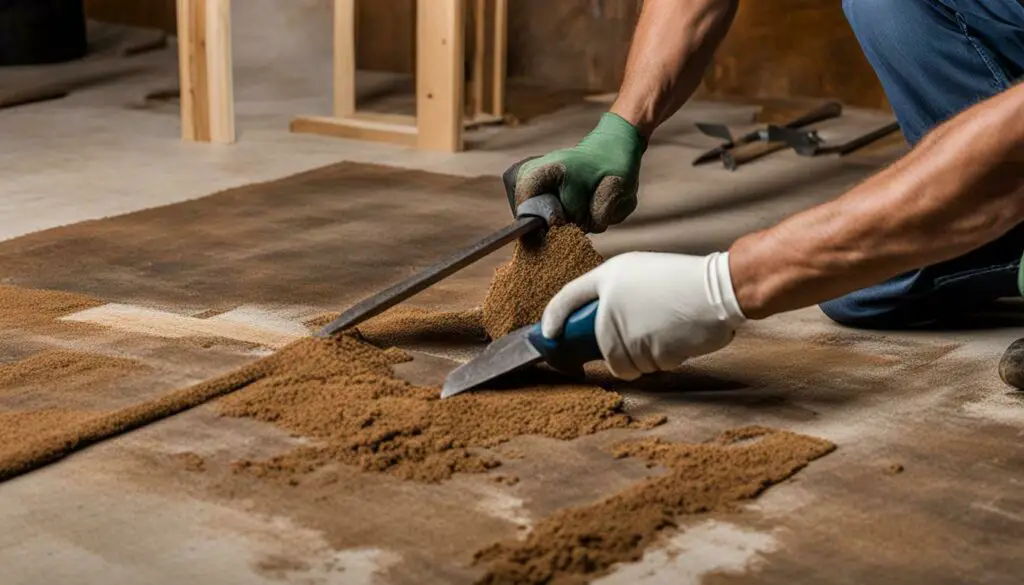
Tips for Preventing Future Accidents
Taking proactive measures can help you prevent future cat urine accidents and keep your carpet free from lingering odors. Here are some tips to help you maintain a clean and odor-free home:
- Retrain your cat: If your cat is frequently having accidents outside the litter box, it may be helpful to retrain them. Ensure that the litter box is easily accessible and kept clean. Consider using a different type of litter or litter box if your cat seems to have a preference.
- Clean litter boxes regularly: Scoop the litter boxes daily and thoroughly clean them at least once a week. Cats are more likely to urinate outside the litter box if it is dirty or unpleasant.
- Use dog-training urine pads: Placing dog-training urine pads under the litter box can provide an added layer of protection against accidents. These pads are designed to absorb liquids and help minimize the spread of urine odor.
- Monitor your cat’s health: Cats may urinate outside the litter box if they have underlying health issues such as urinary tract infections or kidney problems. Keep an eye out for any changes in your cat’s behavior or litter box habits and consult a veterinarian if necessary.
- Create a routine: Cats thrive on routine, so establish a consistent feeding and litter box cleaning schedule. This can help reduce stress and prevent accidents caused by anxiety or confusion.
By implementing these preventative measures, you can maintain a clean and fresh-smelling carpet while providing a comfortable environment for your beloved feline friend. Remember, consistency and patience are key when it comes to preventing cat urine accidents.
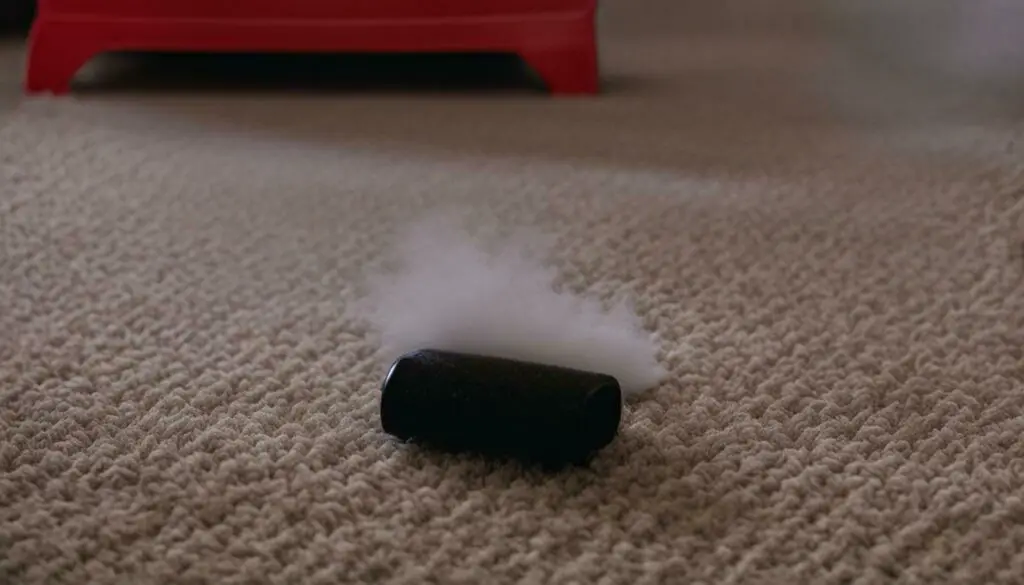
@endsection
Conclusion
With the proven methods and tips shared in this article, you now have the knowledge and tools to successfully get rid of cat urine smell from your carpet and enjoy a fresh and odor-free home.
Professional carpet cleaning is the most effective method for eliminating cat urine odor from your carpet. When choosing a company, ask if they use a hot water extraction process and specialize in pet and urine cleaning. This ensures that the cleaning process is thorough and targeted specifically at removing cat urine smells.
If you prefer to tackle the problem yourself, there are DIY methods that can also be effective. A mixture of vinegar and water, hydrogen peroxide, or baking soda can help neutralize the odor. Before applying these products, it’s important to soak up and remove as much urine as possible using paper towels or a clean cloth.
In addition to cleaning the carpet, it’s crucial to address the root cause of the problem. Retraining your cat and maintaining a clean litter box are essential for preventing future accidents. Using dog-training urine pads under the litter box can provide an added layer of protection.
For stubborn stains and persistent smells, enzyme cleaners are highly recommended. Follow the instructions on the label and thoroughly saturate the affected area. After treating the carpet, rinse the area with clean water and blot with a towel to remove any excess moisture.
If you’re still experiencing lingering smells, a UV light can help identify hidden urine deposits that may be causing the odor. In extreme cases where the smell is deeply ingrained in the carpet pad and subfloor, it may be necessary to replace them entirely.
By implementing these methods and taking preventative measures, you can eliminate cat urine odor from your carpet and create a clean and odor-free living environment for you and your furry friend.
FAQ
How do I get rid of cat urine smell from carpet?
Professional carpet cleaning is the most effective method. Look for a company that uses a hot water extraction process and specializes in pet and urine cleaning. DIY methods can also be used, such as vinegar and water solution, hydrogen peroxide, and baking soda.
How do I remove fresh cat urine and soak up the odor?
Quickly soak up as much urine as possible using paper towels or a clean cloth. Apply pressure to the affected area to draw out the moisture. Once towel-dried, apply an enzyme cleaner to break down the odor-causing compounds.
How can I retrain my cat and maintain a clean litter box?
Make sure to clean the litter box regularly and provide multiple boxes for multiple cats. Use positive reinforcement when retraining your cat, and consider using dog-training urine pads underneath the litter box for added protection against accidents.
What are enzyme cleaners and how do I use them?
Enzyme cleaners are specially formulated to break down the proteins in cat urine, eliminating both the odor and stains. Follow the instructions on the label and thoroughly saturate the affected area with the enzyme cleaner. Allow it to sit for the recommended time before rinsing with clean water and blotting dry.
How can I identify hidden urine deposits?
Using a UV light can help identify hidden urine deposits. Turn off the lights and shine the UV light over the carpet. Urine stains will fluoresce under the light, making them visible and easier to treat.
What should I do in extreme cases where the smell persists?
If the smell persists after trying the above methods, you may need to replace the carpet pad and subfloor. This is a more drastic step that should only be taken in extreme cases where the urine has seeped deep into these layers.
How can I prevent future cat urine accidents?
Retrain your cat using positive reinforcement techniques, keep the litter box clean, and consider using dog-training urine pads underneath the litter box. These pads can help contain any accidents and protect your carpet from future urine stains and odors.
Source Links
- https://www.servicemasterclean.com/servicemaster-of-kalamazoo/tips-and-resources/local-blog/2022/june/how-to-remove-cat-urine-smell-for-good/
- https://shop.truckmountforums.com/blogs/news/how-to-clean-dried-cat-urine-from-a-carpet
- https://www.washingtonpost.com/home/2022/07/18/remove-cat-urine-carpet/

